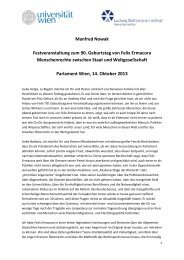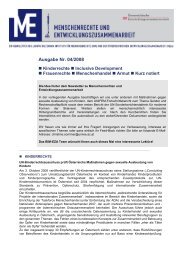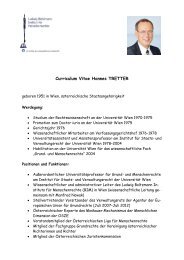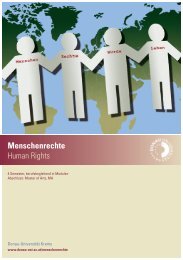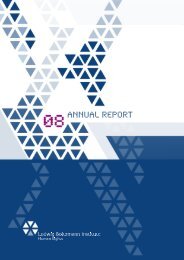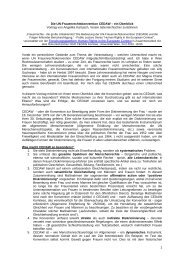Homophobia and Discrimination on Grounds of Sexual Orientation ...
Homophobia and Discrimination on Grounds of Sexual Orientation ...
Homophobia and Discrimination on Grounds of Sexual Orientation ...
Create successful ePaper yourself
Turn your PDF publications into a flip-book with our unique Google optimized e-Paper software.
<str<strong>on</strong>g>Homophobia</str<strong>on</strong>g> <str<strong>on</strong>g>and</str<strong>on</strong>g> <str<strong>on</strong>g>Discriminati<strong>on</strong></str<strong>on</strong>g> <strong>on</strong> <strong>Grounds</strong> <strong>of</strong> <strong>Sexual</strong> Orientati<strong>on</strong> in the EU Member StatesPart I – Legal AnalysisExecutive summaryImplementati<strong>on</strong> <strong>of</strong> Employment Directive 2000/78/ECThe implementati<strong>on</strong> <strong>of</strong> the Employment Equality Directive (Council Directive 2000/78/EC(27.11.2000)) has been variable across the Member States. In eight Member States theEmployment Equality Directive has been implemented as regards sexual orientati<strong>on</strong>discriminati<strong>on</strong>, in the fields designated by Article 3(1) <strong>of</strong> the Directive, i.e., in mattersrelated to work <str<strong>on</strong>g>and</str<strong>on</strong>g> employment. In ten other Member States, the protecti<strong>on</strong> <strong>of</strong>discriminati<strong>on</strong> <strong>on</strong> grounds <strong>of</strong> sexual orientati<strong>on</strong> has been partially extended bey<strong>on</strong>demployment <str<strong>on</strong>g>and</str<strong>on</strong>g> occupati<strong>on</strong>, in order to cover certain but not all fields to which theRacial Equality Directive (Council Directive 2000/43/EC (29.6.2000)) applies – i.e.,bey<strong>on</strong>d work <str<strong>on</strong>g>and</str<strong>on</strong>g> employment, social protecti<strong>on</strong> (social security <str<strong>on</strong>g>and</str<strong>on</strong>g> healthcare), socialadvantages, educati<strong>on</strong>, <str<strong>on</strong>g>and</str<strong>on</strong>g> access to <str<strong>on</strong>g>and</str<strong>on</strong>g> supply <strong>of</strong> goods <str<strong>on</strong>g>and</str<strong>on</strong>g> services which areavailable to the public, including housing. In the nine remaining Member States, thescope <strong>of</strong> the protecti<strong>on</strong> from discriminati<strong>on</strong> <strong>on</strong> grounds <strong>of</strong> sexual orientati<strong>on</strong> has beenextended to all fields covered by the Racial Equality Directive. There is a tendency withinthe States bel<strong>on</strong>ging to the first two groups to join the third group to have the prohibiti<strong>on</strong><strong>of</strong> discriminati<strong>on</strong> <strong>on</strong> grounds <strong>of</strong> sexual orientati<strong>on</strong> in their domestic legislati<strong>on</strong> extendedto all areas to which the prohibiti<strong>on</strong> <strong>of</strong> discriminati<strong>on</strong> <strong>on</strong> grounds <strong>of</strong> race <str<strong>on</strong>g>and</str<strong>on</strong>g> ethnic originapplies.The first chapter focuses <strong>on</strong> three issues that have remained c<strong>on</strong>tentious throughout theimplementati<strong>on</strong> <strong>of</strong> the Employment Equality Directive. First, it examines the hierarchy <strong>of</strong>grounds seemingly established under the two Equality Directives adopted in 2000. Thisreport c<strong>on</strong>cludes that this might not be compatible with the status acquired by theprohibiti<strong>on</strong> <strong>of</strong> discriminati<strong>on</strong> <strong>on</strong> grounds <strong>of</strong> sexual orientati<strong>on</strong> in internati<strong>on</strong>al humanrights law (1.1.). Sec<strong>on</strong>d, it presents an overview <strong>of</strong> equality bodies set up by the EUMember States in the implementati<strong>on</strong> <strong>of</strong> the equality directives <strong>of</strong> 2000, showing that 18Member States have by now <strong>on</strong>e such equality body whose powers extend todiscriminati<strong>on</strong> <strong>on</strong> grounds <strong>of</strong> sexual orientati<strong>on</strong>. The choices facing the Member Statesin setting up such bodies <str<strong>on</strong>g>and</str<strong>on</strong>g> the existing best practices are highlighted (1.2.). Third, itdiscusses whether the prohibiti<strong>on</strong> <strong>of</strong> discriminati<strong>on</strong> <strong>on</strong> grounds <strong>of</strong> sexual orientati<strong>on</strong>might entail a prohibiti<strong>on</strong> <strong>of</strong> differences in treatment between married couples <str<strong>on</strong>g>and</str<strong>on</strong>g> n<strong>on</strong>marriedcouples, whether the latter are de facto durable relati<strong>on</strong>ships or <strong>of</strong>ficiallyregistered. It answers this questi<strong>on</strong> in the affirmative (1.3.).1.1. The hierarchy <strong>of</strong> grounds <strong>of</strong> discriminati<strong>on</strong>. Under current EU law, the prohibiti<strong>on</strong> <strong>of</strong>discriminati<strong>on</strong> <strong>on</strong> grounds <strong>of</strong> race <str<strong>on</strong>g>and</str<strong>on</strong>g> ethnic origin is str<strong>on</strong>ger <str<strong>on</strong>g>and</str<strong>on</strong>g> more extended thanthe prohibiti<strong>on</strong> <strong>of</strong> discriminati<strong>on</strong> <strong>on</strong> any <strong>of</strong> the other grounds menti<strong>on</strong>ed in Article 13 EC,13



